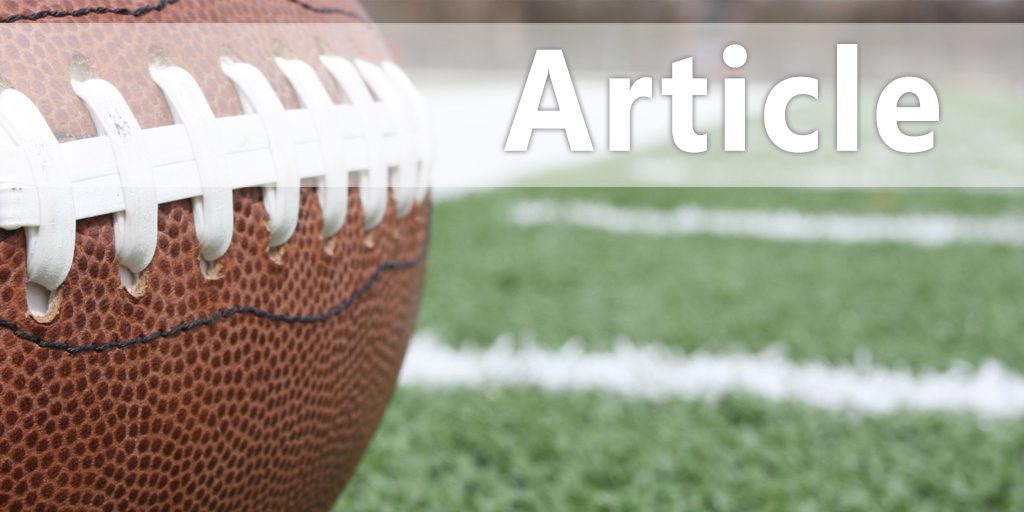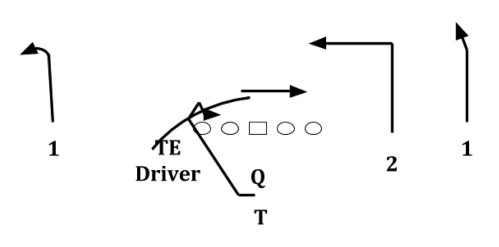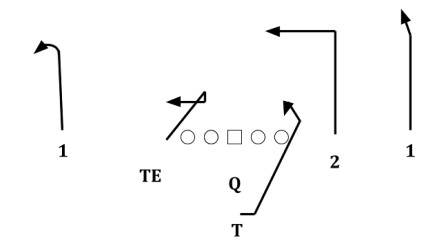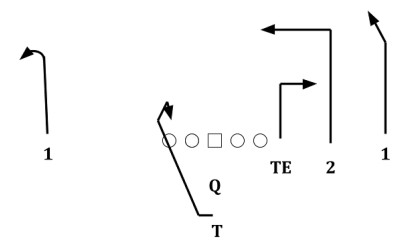| The Drive Series: It is critical for the QB to read coverage early for this
series of plays to be successful |
| By: Kyle Derickson - Elmhurst College
Provided by: American Football Monthly
To make this series and all our pass concepts easier to learn, we give all the plays related names. All of these names have some association with driving a car in order to link the plays within this series. The three things we talk about you can do in a car are 'Drive', 'Crash', or 'Cruise'. DRIVE The first play of the series to be installed is the base Drive play. The Drive starts in a 2 x 2 set and we designate one of our inside receivers (usually the boundary one) to be the Driver. A drive (or drag) route is an immediate crossing route that needs to be at five yards when the receiver gets to the offensive center and continues on that flat path without gaining any ground. It's also important that the receiver takes an immediate angle across the field (or only a slight avoid step if it is a down TE) for the quarterback's timing on the throw as the drive route is usually the first read. In previous years, we gave the Driver the option to continue sprinting or settle down when the player gets to his depth at the opposite offensive tackle. With our team, we took this rule out of the players' hands as the timing and demeanor of our quarterbacks and receivers was just too inconsistent. This option is, however, something you may want to use if your Driver is your best receiver and you are looking for any way to get him the ball. The inside receiver opposite the Driver runs a dig route at 12 yards. Just like the drive route, a key coaching point for the dig route is to make sure the receiver does not gain ground once he has hit his depth. We like to tell our guys to lose half a yard coming out of the break, and naturally, be flat. The tailback completes the triangle by running a hook route out of the backfield. The tailback's route goes to the side where the drive route came from. The hook should be three yards past the LOS and over the offensive tackle. The outside receiver on the same side as the receiver running the drive route will run your best cover 3 five-step beater. We use the 12-yard out route but have also used a wide hook route as well. The route should be an automatic for the quarterback to take if the coverage is cover 3. The outside receiver to the side of the dig route has a deep post. The post should not cross the closest hash and is the "home run" throw for a man-to-man match up or a cover 4 situation if the deep safety bites on the dig route. When the post route sees cover 2, the route becomes a go route down the bottom of the numbers. Diagram 1 shows the TE Drive concept:
The quarterback's options begin during the pre-snap read. Against cover 3, the boundary throw is automatic. If the defense starts running a cloud coverage into the boundary, the QB just reads his inside triangle starting with the drive to the dig to the tailback. The inside triangle is good against any coverage, but if you have a quarterback that you will allow to take chances, then giving him the option to throw the post route vs. cover 4 or man coverage is a great option. The other option our QB has is to change the boundary route when he sees man coverage giving him another great catchup route. Specifically for the inside triangle, the QB needs to read defenders. His first look goes to the LB apexing the #2 receiver who is running the dig route. If the LB drops with the dig, the QB will deliver the ball to the drive as it comes across replacing where that LB was. If that LB squares up to take away the drive, the QB must find that next inside LB. If he drops vertical, the QB should deliver the ball to the dig right out of the break. If the LB drops to cover the dig, the QB should check down to the tailback. CRASH The Crash play is a 2 x 2 compliment to the Drive play. The post, dig, and out routes are run once again by the same receivers. The crash or whip route is run by the called receiver or, in the case of the Drive example, the TE. Since the TE is no longer going across the field, in order to complete the triangle, the tailback will run the same hook route but to the opposite side of where the TE is (Diagram 2).
The QB's read now begins with the LB over the TE. If he passes off the TE to the next LB, the QB should throw to the TE as soon as he turns. This brings up a coaching point for our TE: don't be in a hurry to whip out. The TE is taught to turn and sit for a quick throw before whipping out flat to the outside. If the TE is covered by the next inside LB, then the QB should throw the dig route behind him. The only one who can cover the dig at this point is the next LB who would be leaving the tailback open on his hook route. Similar to the Drive play, the Crash play has options for different coverages. Man-to-man and cover 4 create an opportunity for the post route while cover 3 gives the QB his choice route on the backside (the out route in the diagram). When the QB is in doubt, the triangle read works for all coverages. CRUISE The Cruise play takes the Drive Series to a 3 x 1 formation. Once again, the post, dig, and out routes are all the same. The tailback runs the hook route opposite the three-receiver side. The third receiver's job is now to be the Cruiser. He does this by running a 5-yard square-out and ends up in the same place as the Driver did in the first play of the series (Diagram 3).
The quarterback reads are identical to the Drive play. With the TE ending up in the same place as he does when he runs the drive route from a 2 x 2 formation, it makes for an easy compliment to Drive. The TE does not always have to be the Cruiser for this play. The play can be run with the #2 WR running the Cruise with #3 running the dig. The adjustment that needs to be made for this to work is that the #2 WR must run a whip route. The whip route pushes the #2 WR inside so that when he comes back out, he is at the same point where the TE is when he just cuts out. If the #2 WR were to run the same square-out that the TE runs, he would be too wide making for a tougher triangle read for the quarterback. |









